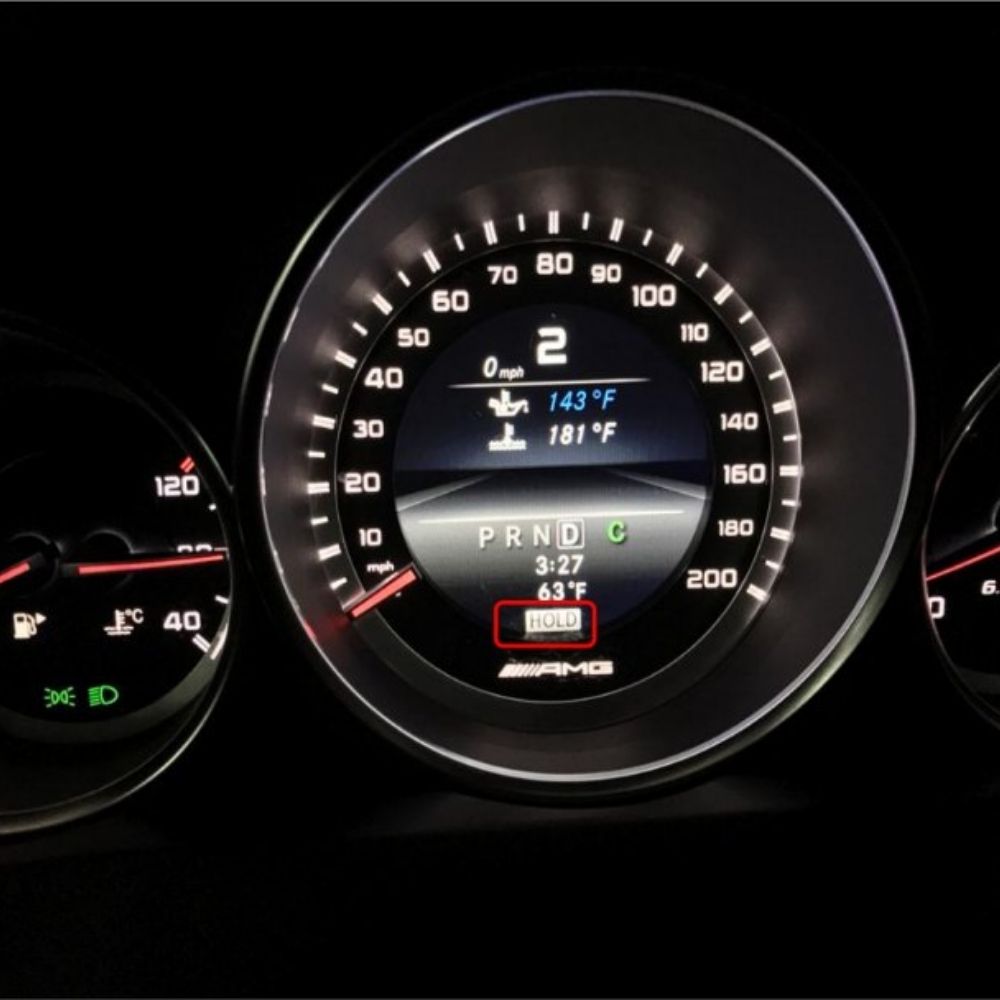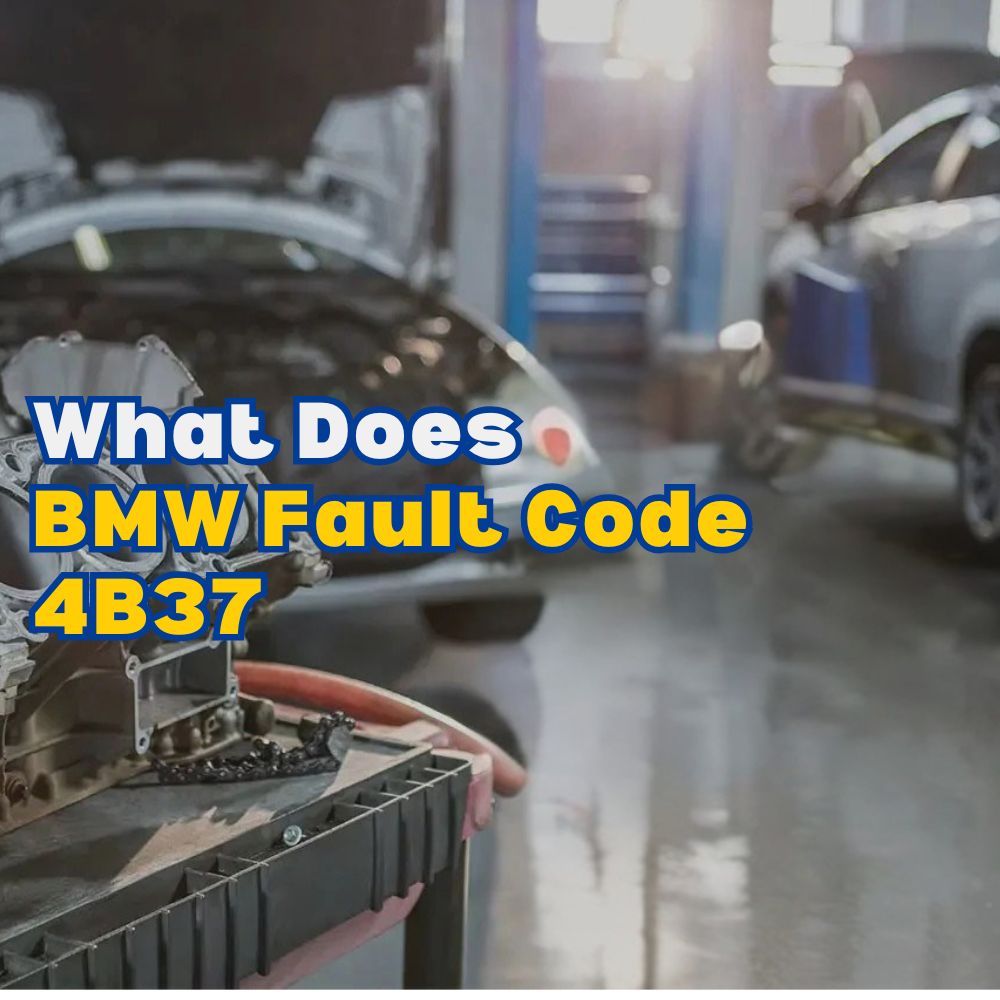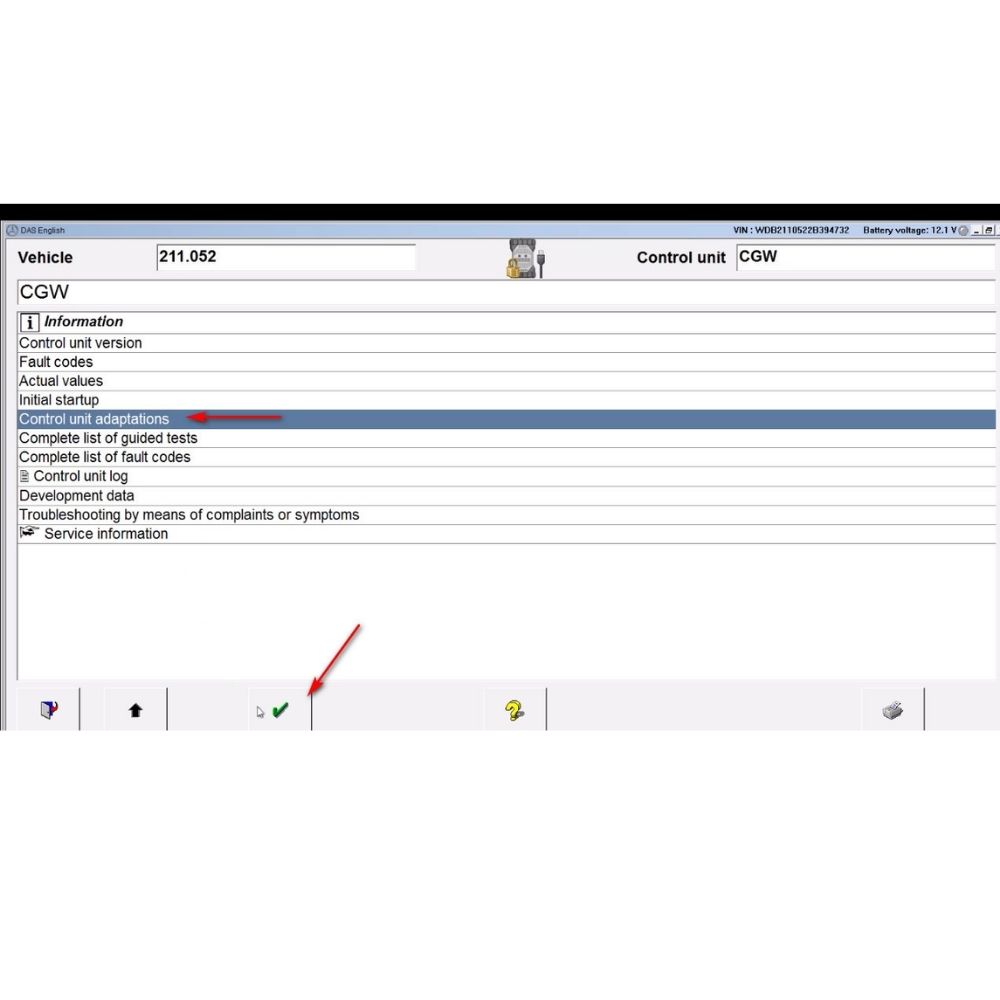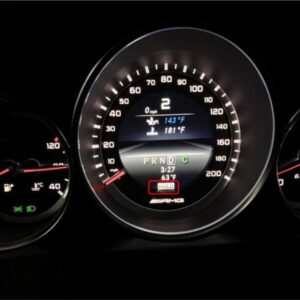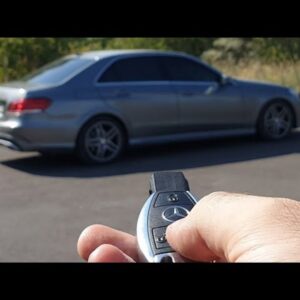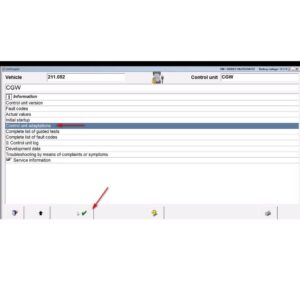The BMW fault code 4B37 indicates an issue with the oil condition sensor, also referred to as “Oil condition sensor (layer QLT).” This sensor is crucial for monitoring the quality and condition of your engine oil. AutoExplain is ready to help you diagnose and repair your BMW remotely.
1. What is BMW Fault Code 4B37 and What Does It Mean?
BMW fault code 4B37 signifies a malfunction or reading outside the expected range from the oil condition sensor. This sensor plays a vital role in assessing the state of the engine oil, including its viscosity, contamination levels, and overall degradation. When this fault code appears, it suggests that the sensor is either providing inaccurate data or has failed completely, leading to potential issues with the engine management system’s ability to properly monitor and protect the engine. In essence, this fault code means that the Engine Control Unit (ECU) is not receiving reliable data about the oil’s condition, which can affect performance and longevity.
1.1 Why is the Oil Condition Sensor Important in a BMW?
The oil condition sensor is a vital component in modern BMWs for several reasons:
- Extended Oil Change Intervals: The sensor allows for extended oil change intervals by monitoring the actual condition of the oil, rather than relying on fixed mileage or time-based schedules.
- Engine Protection: By detecting oil degradation or contamination, the sensor helps protect the engine from potential damage due to poor lubrication.
- Optimal Performance: Proper oil condition ensures optimal engine performance and fuel efficiency.
- Early Problem Detection: The sensor can detect early signs of engine problems, such as coolant leaks or fuel dilution, which can affect oil quality.
1.2 What are the Symptoms Associated with Fault Code 4B37?
Several symptoms may accompany the 4B37 fault code, indicating a problem with the oil condition sensor:
- Check Engine Light: The most common symptom is the illumination of the check engine light on the dashboard.
- Inaccurate Oil Level Readings: The oil level reading on the iDrive display may be inaccurate or fluctuate erratically.
- Premature Oil Change Required Message: The vehicle may display a message indicating that an oil change is required sooner than expected.
- Reduced Engine Performance: In some cases, the engine’s performance may be affected, leading to reduced power or fuel efficiency.
- Idling Problems: Rough idling or stalling can occur if the oil condition is severely compromised.
1.3 What are the Potential Causes of the 4B37 Fault Code?
Several potential causes can trigger the 4B37 fault code, including:
- Faulty Oil Condition Sensor: The sensor itself may be defective and require replacement.
- Wiring Issues: Damaged or corroded wiring connecting the sensor to the ECU can cause communication problems.
- Connector Problems: Loose or corroded connectors can disrupt the signal from the sensor.
- Oil Contamination: Severely contaminated oil can affect the sensor’s accuracy.
- ECU Issues: In rare cases, a problem with the ECU can cause false readings or fault codes.
2. Diagnosing BMW Fault Code 4B37: A Step-by-Step Guide
Diagnosing the 4B37 fault code requires a systematic approach to identify the root cause of the problem. Here’s a step-by-step guide to help you through the process:
2.1 Initial Inspection and Code Verification
- Read the Fault Code: Use an OBD-II scanner, preferably one compatible with BMW-specific codes, to confirm the presence of the 4B37 fault code.
- Record the Code: Note down any other related fault codes that may be present. These can provide additional clues.
- Clear the Code: Clear the fault code and see if it reappears after a short test drive. This helps confirm if the issue is persistent.
2.2 Physical Inspection of the Oil Condition Sensor
- Locate the Sensor: The oil condition sensor is typically located on the oil pan or near the oil filter housing. Refer to your BMW’s service manual for the exact location.
- Check the Wiring: Inspect the wiring and connectors leading to the sensor for any signs of damage, such as frayed wires, corrosion, or loose connections.
- Inspect the Connector: Disconnect the connector and check for corrosion or bent pins. Clean the connector with electrical contact cleaner if necessary.
2.3 Testing the Oil Condition Sensor
- Check Sensor Resistance: Use a multimeter to check the resistance of the sensor. Compare the reading with the specifications in your BMW’s service manual. An incorrect resistance value indicates a faulty sensor.
- Check for Voltage: With the ignition on, use a multimeter to check for voltage at the sensor connector. You should find a reference voltage (typically 5V).
- Signal Check: Use an oscilloscope or advanced diagnostic tool to check the signal from the sensor while the engine is running. Look for any abnormalities or interruptions in the signal.
2.4 Checking the Oil Quality
- Visual Inspection: Examine the engine oil for signs of contamination, such as coolant or fuel.
- Smell Test: Smell the oil for any unusual odors, such as a gasoline smell, which could indicate fuel dilution.
- Oil Analysis: For a more thorough assessment, send an oil sample to a laboratory for analysis. This can reveal the presence of contaminants and the overall condition of the oil.
2.5 Using Diagnostic Tools for Live Data
- Access Live Data: Use a diagnostic tool to access live data from the oil condition sensor while the engine is running.
- Monitor Readings: Monitor the sensor readings for accuracy and consistency. Look for any sudden drops or spikes in the data.
- Compare with Specifications: Compare the live data readings with the expected values in your BMW’s service manual.
2.6 Common Mistakes to Avoid During Diagnosis
- Ignoring Other Fault Codes: Always consider other related fault codes that may provide additional insights into the problem.
- Not Checking Wiring Thoroughly: Wiring issues are a common cause of sensor problems, so make sure to inspect the wiring and connectors carefully.
- Assuming the Sensor is Always Faulty: The sensor may be functioning correctly, but the problem could be due to oil contamination or an ECU issue.
- Not Using the Correct Diagnostic Tools: Using generic OBD-II scanners may not provide accurate or complete information. Use a BMW-specific diagnostic tool whenever possible.
3. Repairing BMW Fault Code 4B37: Solutions and Procedures
Once you’ve diagnosed the cause of the 4B37 fault code, you can proceed with the necessary repairs. Here are some solutions and procedures to address the issue:
3.1 Replacing a Faulty Oil Condition Sensor
- Disconnect the Battery: Before starting any repair work, disconnect the negative terminal of the battery to prevent electrical shorts.
- Locate the Sensor: Find the oil condition sensor on the oil pan or near the oil filter housing.
- Disconnect the Connector: Disconnect the electrical connector from the sensor.
- Remove the Old Sensor: Use the appropriate wrench or socket to remove the old sensor. Be prepared for some oil to spill out.
- Install the New Sensor: Install the new sensor, making sure to tighten it to the specified torque.
- Reconnect the Connector: Reconnect the electrical connector to the sensor.
- Reconnect the Battery: Reconnect the negative terminal of the battery.
- Clear the Fault Code: Use a diagnostic tool to clear the 4B37 fault code.
- Test the System: Start the engine and monitor the oil level reading on the iDrive display to ensure it is accurate.
3.2 Repairing Wiring and Connector Issues
- Inspect the Wiring: Carefully inspect the wiring leading to the sensor for any signs of damage, such as frayed wires or corrosion.
- Repair Damaged Wires: Repair any damaged wires by splicing in new sections of wire and using heat-shrink tubing to protect the connections.
- Clean Corroded Connectors: Clean any corroded connectors with electrical contact cleaner.
- Replace Damaged Connectors: If a connector is severely damaged, replace it with a new one.
- Secure Connections: Make sure all connections are secure and properly seated.
3.3 Addressing Oil Contamination Issues
- Change the Oil and Filter: If the oil is contaminated, perform a complete oil and filter change.
- Use the Correct Oil: Make sure to use the correct type and viscosity of oil recommended for your BMW.
- Check for Leaks: Inspect the engine for any leaks that may be causing oil contamination, such as coolant or fuel leaks.
- Address Underlying Issues: Repair any underlying issues that are causing oil contamination, such as a leaking head gasket or faulty fuel injectors.
3.4 Resetting the Oil Condition Sensor
- Use a Diagnostic Tool: Use a diagnostic tool to reset the oil condition sensor after performing an oil change.
- Follow the Procedure: Follow the instructions in your BMW’s service manual for resetting the sensor.
- Verify the Reset: Verify that the sensor has been reset by checking the oil level reading on the iDrive display.
3.5 When to Seek Professional Help
While many repairs can be performed by experienced DIYers, some situations require professional assistance:
- Complex Wiring Issues: If you are not comfortable working with electrical wiring, it is best to seek help from a qualified technician.
- ECU Problems: If you suspect that the ECU is the cause of the problem, it is best to have it diagnosed and repaired by a professional.
- Uncertain Diagnosis: If you are unsure about the cause of the 4B37 fault code, it is best to seek help from a qualified technician.
AutoExplain offers remote diagnostic and repair services to assist you with complex issues. Contact us via WhatsApp at +1(936)2896695 or email us at [email protected] for expert assistance.
4. Preventing Future Issues with the Oil Condition Sensor
Preventing future issues with the oil condition sensor involves regular maintenance and proactive care. Here are some tips to help you keep your BMW running smoothly:
4.1 Regular Oil Changes and Maintenance
- Follow Recommended Intervals: Adhere to the oil change intervals recommended by BMW.
- Use Quality Oil and Filters: Use high-quality oil and filters that meet BMW’s specifications.
- Check Oil Level Regularly: Check the oil level regularly and top off as needed.
4.2 Monitoring Oil Quality
- Visual Inspections: Periodically inspect the oil for signs of contamination or degradation.
- Oil Analysis: Consider sending oil samples for analysis to monitor the oil’s condition more closely.
4.3 Addressing Leaks Promptly
- Inspect for Leaks: Regularly inspect the engine for any oil or coolant leaks.
- Repair Leaks Immediately: Repair any leaks promptly to prevent oil contamination and potential engine damage.
4.4 Keeping the Engine Clean
- Regular Cleaning: Keep the engine clean to prevent dirt and debris from contaminating the oil.
- Avoid Harsh Chemicals: Avoid using harsh chemicals when cleaning the engine, as these can damage the oil condition sensor.
4.5 Proper Driving Habits
- Avoid Short Trips: Avoid frequent short trips, as these can cause condensation to build up in the oil.
- Warm-Up Engine: Allow the engine to warm up properly before driving at high speeds.
By following these preventive measures, you can minimize the risk of future issues with the oil condition sensor and keep your BMW running smoothly for years to come.
5. Advanced Tips and Tricks for BMW Owners
For BMW owners who want to take their knowledge and maintenance skills to the next level, here are some advanced tips and tricks:
5.1 Understanding BMW Diagnostic Software
- BMW ISTA: Learn how to use BMW’s Integrated Service Technical Application (ISTA) for advanced diagnostics and programming.
- BMW Coding: Explore the world of BMW coding to customize vehicle settings and enable hidden features.
5.2 Using Multimeters and Oscilloscopes Effectively
- Multimeter Techniques: Master the use of a multimeter for testing voltage, resistance, and continuity in automotive circuits.
- Oscilloscope Analysis: Learn how to use an oscilloscope to analyze electrical signals and diagnose complex sensor issues.
5.3 Reading Wiring Diagrams
- Understanding Symbols: Familiarize yourself with the symbols and conventions used in automotive wiring diagrams.
- Tracing Circuits: Learn how to trace circuits and identify potential wiring issues using wiring diagrams.
5.4 Upgrading Your Diagnostic Tools
- BMW-Specific Scanners: Invest in a high-quality BMW-specific diagnostic scanner for accurate and comprehensive diagnostics.
- Advanced Tools: Consider adding advanced tools such as a compression tester, leak-down tester, and smoke machine to your diagnostic arsenal.
5.5 Joining BMW Forums and Communities
- Online Forums: Join online BMW forums and communities to share knowledge, ask questions, and learn from other enthusiasts.
- Local Clubs: Consider joining a local BMW club to connect with other owners and participate in events and workshops.
6. How AutoExplain Can Help with Your BMW Issues
At AutoExplain, we understand the complexities of modern automotive systems and the challenges faced by technicians and DIY enthusiasts. That’s why we offer a range of services to help you diagnose and repair your BMW quickly and efficiently.
6.1 Remote Diagnostic Services
Our remote diagnostic services provide you with expert assistance from the comfort of your own garage. Using advanced diagnostic tools and software, we can remotely access your vehicle’s ECU and diagnose a wide range of issues, including the 4B37 fault code.
6.2 ECU Programming and Coding
We offer ECU programming and coding services to help you update your vehicle’s software, enable new features, and optimize performance. Whether you need to reprogram an ECU after a repair or code a new module, our team of experts can help.
6.3 Technical Support and Training
We provide technical support and training to help you expand your knowledge and skills. Whether you’re a professional technician or a DIY enthusiast, our training programs can help you master the latest diagnostic and repair techniques.
6.4 Benefits of Using AutoExplain
- Expert Assistance: Our team of experienced technicians and engineers are experts in BMW diagnostics and repair.
- Fast and Efficient: We provide fast and efficient service to minimize downtime and get you back on the road as soon as possible.
- Cost-Effective: Our services are cost-effective compared to traditional repair shops.
- Convenient: Our remote services allow you to get expert assistance from the comfort of your own garage.
Don’t let the 4B37 fault code keep you off the road. Contact AutoExplain today via WhatsApp at +1(936)2896695 or email us at [email protected] for expert assistance. Our office is located at 1500 N Grant ST Sten Denver, CO 80203. Visit our website at AutoExplain for more information.
7. The Role of E-E-A-T and YMYL in Automotive Repair Content
In the realm of online content, especially in sectors like automotive repair, adhering to the principles of Expertise, Authoritativeness, Trustworthiness (E-E-A-T) and Your Money or Your Life (YMYL) is paramount. These guidelines, emphasized by Google, ensure that the information presented is not only accurate but also reliable and safe for the end-user.
7.1 Understanding E-E-A-T
- Expertise: Demonstrating a high level of knowledge and skill in the subject matter. In automotive repair, this involves having a deep understanding of vehicle systems, diagnostic procedures, and repair techniques.
- Authoritativeness: Being recognized as a credible source of information within the industry. This can be achieved through certifications, endorsements, and positive reviews.
- Trustworthiness: Establishing a reputation for honesty and transparency. This includes providing accurate information, citing sources, and avoiding misleading claims.
7.2 The Significance of YMYL in Automotive Repair
Automotive repair falls under the YMYL category because the information provided can directly impact a person’s safety and financial well-being. Incorrect advice or faulty repair procedures can lead to vehicle damage, accidents, or even injuries. Therefore, it is crucial to ensure that all content is accurate, reliable, and up-to-date.
7.3 Implementing E-E-A-T and YMYL in Content Creation
- Research and Accuracy: Conduct thorough research and verify all information before publishing.
- Qualified Authors: Use authors with relevant experience and expertise in automotive repair.
- Citations and Sources: Cite reputable sources, such as manufacturer service manuals and industry publications.
- Clear and Concise Language: Use clear and concise language that is easy to understand.
- Visual Aids: Incorporate visual aids, such as diagrams and images, to enhance understanding.
- Regular Updates: Regularly update content to reflect the latest industry standards and best practices.
- User Feedback: Encourage user feedback and address any concerns or errors promptly.
8. FAQ About BMW Fault Code 4B37
Here are some frequently asked questions about BMW fault code 4B37:
8.1 Can I drive my BMW with fault code 4B37?
It is generally safe to drive with the 4B37 fault code, but it is not recommended to do so for an extended period. The fault code indicates a problem with the oil condition sensor, which can affect the engine’s ability to monitor oil quality accurately. Driving with this fault code for too long can lead to potential engine damage.
8.2 How much does it cost to replace the oil condition sensor?
The cost to replace the oil condition sensor can vary depending on the make and model of your BMW, as well as the labor rates in your area. Generally, the cost ranges from $200 to $400, including parts and labor.
8.3 Can a faulty oil condition sensor cause other problems?
Yes, a faulty oil condition sensor can cause other problems, such as inaccurate oil level readings, premature oil change required messages, and reduced engine performance. In some cases, it can also lead to rough idling or stalling.
8.4 How do I know if my oil condition sensor is bad?
You can determine if your oil condition sensor is bad by checking for symptoms such as the check engine light, inaccurate oil level readings, and premature oil change required messages. You can also use a multimeter to check the sensor’s resistance and voltage.
8.5 Can I replace the oil condition sensor myself?
If you have experience working on cars and are comfortable with basic automotive repairs, you may be able to replace the oil condition sensor yourself. However, it is important to follow the correct procedures and use the appropriate tools. If you are not comfortable performing the repair yourself, it is best to seek help from a qualified technician.
8.6 How often should I change my oil?
The oil change intervals recommended by BMW vary depending on the model and driving conditions. Generally, BMW recommends changing the oil every 10,000 to 15,000 miles or once a year, whichever comes first. However, if you drive in severe conditions, such as frequent stop-and-go traffic or extreme temperatures, you may need to change the oil more frequently.
8.7 What type of oil should I use in my BMW?
It is important to use the correct type and viscosity of oil recommended for your BMW. Refer to your owner’s manual or service manual for the recommended oil specifications. Using the wrong type of oil can lead to engine damage.
8.8 Can I reset the oil condition sensor without a diagnostic tool?
In some cases, you may be able to reset the oil condition sensor without a diagnostic tool by following a specific sequence of steps. However, this method may not work for all BMW models. It is generally recommended to use a diagnostic tool to reset the sensor.
8.9 Where is the oil condition sensor located?
The oil condition sensor is typically located on the oil pan or near the oil filter housing. Refer to your BMW’s service manual for the exact location.
8.10 How do I clear the 4B37 fault code?
You can clear the 4B37 fault code using an OBD-II scanner or diagnostic tool. Simply connect the scanner to the OBD-II port and follow the instructions to clear the fault code.
9. Call to Action: Get Expert Help from AutoExplain
Are you struggling with the 4B37 fault code or other complex BMW issues? Don’t waste time and money on trial-and-error repairs. Contact AutoExplain today for expert remote diagnostic and repair services.
Our team of experienced technicians and engineers can help you diagnose the problem quickly and efficiently, and provide you with the guidance you need to get your BMW back on the road.
Contact us today:
When 4B37 fault code triggers unexpected problems, rely on AutoExplain for precise diagnostics and proven guidance. Contact us through WhatsApp at +1 (936) 289 6695 or email [email protected] for expert assistance. Our headquarters is located at 1500 N Grant St, Denver, CO 80203. Learn more on the AutoExplain website to keep your vehicle running smoothly.
Let AutoExplain be your trusted partner for all your BMW diagnostic and repair needs.
